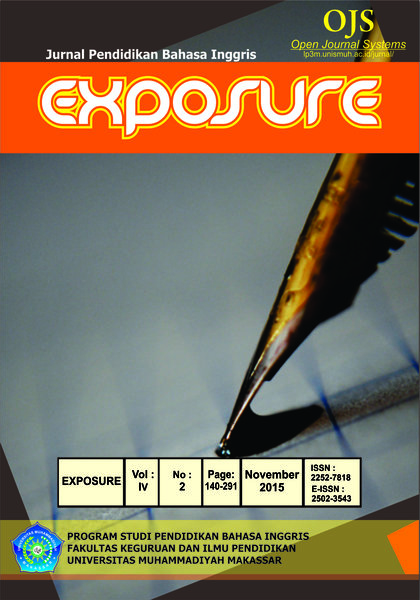IMPROVING THE STUDENTS READING COMPREHENSION IN NARRATIVE TEXT THROUGH PATTERNED PARTNER READING
DOI:
https://doi.org/10.26618/exposure.v4i2.923Abstrak
This research aimed to find the use of Patterned Partner Reading strategy improve the students reading comprehension at the SMP Muhammadiyah Limbung. The researcher used A Classroom Action Research (CAR). The researcher had conducted two cycles, where each cycle consisted of four meetings. This classroom action research was one at SMP Muhammadiyah Limbung. As subject in this research was the second class with students’ number as about 30 students consist of 7 man and 23 women. The instruments were observation sheet and test sheet. The research findings indicated that the application of patterned partner reading strategy was effective and significant in improving the students’ reading skill especially students’ reading comprehension. It was proved that the mean score of D-Test was 60.8, Cycle I 75.5 and after conducted Cycle II improved to 93 And based of mean score of students’ reading comprehension during two cycle researcher found percentage improvement that is from D-Test to Cycle I is 24.17% and from Cycle I to Cycle II is 23.17 and D-Test to Cycle II 52.96%. It means that there was the improvement of students’ reading comprehension on learning process.
Referensi
Alexander, A. 1998 Teaching Reading (www.Nclrc. Org/reading/reindex). Retrieved on October 20, 2009.
Basri D., Muhammad. 2010. Fundamental of Research Methodology. Makassar
Byrnes, Heldi.1998. Teaching Reading. London: Scott, Foresman and Company.
Berrs, Kylene. 2000. All America Reads. Secondary Reading Strategies (online)
http://www.qeh.ednet.ns.ca/literacy/Reluctant%20Readers%20Wish%20You%20Well.pdf
Carillo. 1976. Teaching Reading London. London: Second Edition USA: Addition Prentice
Charles A. Perfetti. 2001. Reading Skills Learning Research and Development Center. Oxford: Pergamon.
Cross, P., & Steadman, M. (1996). Classroom Research: Implementing the Scholarship of Teaching, San Francisco: Jossey-Bass.
Dixonkrauss, L. (1995). Partner Reading and Writing: Peer Social Dialog and the Zone of Proximal Development. Journal of Reading Behavior, 27, 45.
Englishindo. 2012. (online) http://www.englishindo.com/2012/01/narrative-text-penjelasan-contoh.html
Elizabeth B. Meisinger. 2002. Quality of Interaction During Partner Reading. Journal of Literacy at jlr.sagepub.com
Goodman. 1988. Ten Steps to Building College Reading Skills. Townsend: Townsend Press.
Heinemann. 2009. Reading Process Brief Edition of Reading Process and Practice Third edition. Oxford.
Jamie R. 2005. Improving Student Reading Fluency to Impact Reading Comprehension. Pawnee Elementary School.
Kareen Haag. 2012. Partner Reading. A Free Resource For People Passionate About Helping All Students Enjoy Reading. (online) Available on: http://www.liketoread.com/partner_reading.html
Mclauglin and Allen. 2002. Critical Literacy: Enhancing Students Comprehension of Text. New York. Scholastic.42.
Nilson, L.B. (1998). Teaching at its Best. Bolton, MA: Anker Publishing.
Nuttal, N. 1988. Teaching Reading Skill in Foreign Language. Oxford: Heinemann International Publishing Company.
Rohim, Fathur. 2010. Teaching Reading. Jakarta: Ministry of National Education.
Saddleback. 2002. Reading Comprehension Skills and Strategies Level 7. United States of America Saddleback Educational Publishing Three Watson.
Susan Roberts, 2000. National Reading Panel Research. Reading Specialist Jefferson County Schools.
Unduhan
Diterbitkan
Terbitan
Bagian
Lisensi
Authors who publish with this journal agree to the following terms:
In order to assure the highest standards for published articles, a peer review policy is applied. In pursue of the compliance with academic standards, all parties involved in the publishing process (the authors, the editors and the editorial board and the reviewers) agree to meet the responsibilities stated below in accordance to the Journal publication ethics and malpractice statement.
Duties of Authors:
- The author(s) warrant that the submitted article is an original work, which has not been previously published, and that they have obtained an agreement from any co-author(s) prior to the manuscript’s submission;
- The author(s) should not submit articles describing essentially the same research to more than one journal;
- The authors(s) make certain that the manuscript meets the terms of the Manuscript Submission Guideline regarding appropriate academic citation and that no copyright infringement occurs;
- The authors(s) should inform the editors about any conflict of interests and report any errors they subsequently, discover in their manuscript.
Duties of Editors and the Editorial Board:
- The editors, together with the editorial board, are responsible for deciding upon the publication or rejection of the submitted manuscripts based only on their originality, significance, and relevance to the domains of the journal;
- The editors evaluate the manuscripts compliance with academic criteria, the domains of the journal and the guidelines;
- The editors must at all times respect the confidentiality of any information pertaining to the submitted manuscripts;
- The editors assign the review of each manuscript to two reviewers chosen according to their domains of expertise. The editors must take into account any conflict of interest reported by the authors and the reviewers.
- The editors must ensure that the comments and recommendations of the reviewers are sent to the author(s) in due time and that the manuscripts are returned to the editors, who take the final decision to publish them or not.
Authors are permitted and encouraged to post online a pre-publication manuscript (but not the Publisher’s final formatted PDF version of the Work) in institutional repositories or on their Websites prior to and during the submission process, as it can lead to productive exchanges, as well as earlier and greater citation of published work (see The Effect of Open Access). Any such posting made before acceptance and publication of the Work shall be updated upon publication to include a reference to the Publisher-assigned DOI (Digital Object Identifier) and a link to the online abstract for the final published Work in the Journal.

